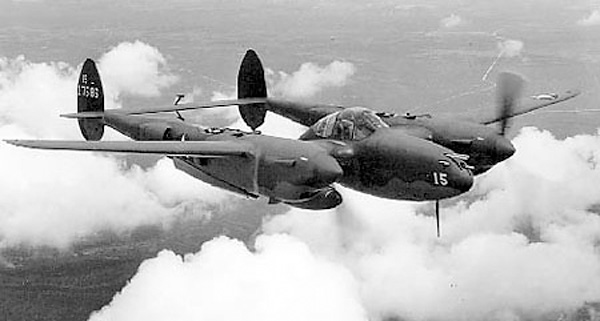P-38 Lightning was a military airplane used by the United States during World War II (1939-1945). The P-38 was a twin-engine fighter (fast-flying airplane with weapons) developed by the Lockheed Corporation. At that time, P was the U.S. Army’s designation for a pursuit (fighter) plane. The P-38 was one of the most famous fighters of World War II. Lockheed aeronautical engineer Kelly Johnson designed the aircraft. See Johnson, Clarence Leonard .
The Lightning had a unique “three-pronged” design. Seen from the front, a central nacelle (compartment for the pilot and weapons) protruded from between two booms. The twin booms formed a frame connecting the plane’s central structure to its tail. At the plane’s tail, a single horizontal stabilizer connected the vertical fins at the rear of each boom. A stabilizer is like a small wing in the tail. It prevents the tail from bobbing up and down. Fins stand upright, keeping the rear of the plane from swinging left to right.

The P‑38 was the first fighter with tricycle landing gear. The gear included a wheel under the plane’s nose and a wheel beneath each wing. Most P-38’s carried one pilot, four heavy machine guns, and one rapid-fire cannon. Unlike planes with wing-mounted guns, the P-38 had its firepower concentrated at the plane’s center. This arrangement gave the weapons a devastating “buzz saw” effect.
Engines made by the Allison Engine Company gave the P-38 a top speed of about 415 miles (668 kilometers) per hour. The P-38’s maximum altitude was around 44,000 feet (13,400 meters). Its range with _drop tanks—_exterior fuel tanks attached beneath each wing—was about 2,600 miles (4,200 kilometers).
The Lockheed Corporation tested P-38 prototypes (early models) in 1939. In April 1942, the planes began flying reconnaissance (information gathering) missions in the Pacific. The first P-38 combat victory over a Japanese plane occurred over Alaska’s Aleutian Islands on August 4. Ten days later, a P-38 shot down its first German plane over Iceland. Later that year, the planes began flying combat missions in North Africa. In 1943, P-38’s began escorting bombers (airplanes that drop explosives) to and from European targets. The versatile P-38’s also flew many of their own bombing missions. The fighters provided air cover, reconnaissance, and ground support during the Allied invasions of Italy and France.
P-38’s served extensively in the Pacific, where they shot down more Japanese aircraft than any other Allied warplane. On April 18, 1943, Lightnings gained fame for shooting down a plane carrying Japanese Admiral Isoroku Yamamoto. Yamamoto, commander of the Imperial Japanese Navy, had planned the 1941 attack on U.S. forces at Pearl Harbor. See Yamamoto, Isoroku ; Pearl Harbor .
P-38 fighters destroyed thousands of enemy aircraft, ships, and ground targets during World War II. More than 10,000 P-38’s were built. The last Lightning in U.S. service was retired in 1949. Some foreign air forces continued to fly the plane for a number of years.
See also Aircraft, Military ; Fighter plane ; Lockheed Corporation ; World War II (The air war) .
